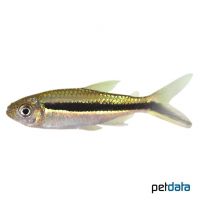False Penguin Tetra (Thayeria boehlkei)
| False Penguin Tetra Thayeria boehlkei | |
|---|---|
| Name | False Penguin Tetra |
| Name Lat. | Thayeria boehlkei |
| Family | Characins |
| Family lat. | Characidae |
| Order | Characins |
| Order lat. | Characiformes |
| Origin | Brazil, Peru |
| Habitat | Rivers, forest streams |
| Diet | Carnivore |
| pH | 6.0-8.0 |
| Behavior | Peaceful |
| Keeping | Group |
| Care Level | Moderate |
| Reproduction | Egg scatterer |
| Breeding | Moderately difficult |
| Life Span | 4-6 years |
| Protection | No |
| Metric Units | |
| Size | 5 cm |
| Temperature | 22-28 °C |
| Hardness | 5-20 °dH |
| Aquarium | ~ 60 l |
| US Units | |
| Size | 2" |
| Temperature | 72-82 °F |
| Hardness | 89-356 ppm |
| Aquarium | ~ 15 gal |
Distribution and habitat
Oblique swimmers are native to the watersheds of the upper Amazon River (Peru) and the Rio Araguaia (Brazil). They occur in a variety of habitats, such as weedy waters in wetlands or in jungle streams with dense riparian vegetation and few aquatic plants
Maintenance
The aquarium should have a varied, partly dense planting, with shelters and hiding places (roots) and provide sufficient swimming space. A dark substrate covered with some foliage (e.g. sea almond leaves), shaded light (floating plants) and a weak current is ideal.
No ammonia, ammonium and nitrite should be detectable, the nitrate value should not exceed 100 mg/l. To ensure the water quality and oxygen content, a filter and heater adapted to the aquarium size is required, as well as lighting for the species-appropriate day-night rhythm of the animals.
Diet
In nature they feed mainly on small insects and larvae. The food supply consists of live, frozen and dry food. For a balanced diet, feed once a day with a high-quality, protein-rich dry food (flakes, granules, pellets) as well as cyclops, moina, daphnia, artemia, etc. (live or frozen).
It is recommended to feed small portions several times a day, which are eaten within a few minutes. A regular and varied diet promotes health and increases resistance.
Behaviour and compatibility
They are very peaceful, calm schooling fish and well suited for a community tank with other, not too large and peaceful fish. At least 5, but better more slant swimmers should be kept together.
Basically, only mutually compatible fish species with similar demands on water conditions and water temperature should be socialized.
Sex dimorphism
The females appear somewhat rounder and are less intensely colored.
Reproduction and breeding
In soft, slightly acidic peat water they usually spawn between fine-feathered plants (free spawners). The larvae hatch after 12-24 hours and swim freely after 3-4 days.
Juveniles must be fed several times a day with special rearing food (dust food). In community tanks breeding is hardly possible, because the spawn is easy prey.
Important
They got their name because they usually swim with their heads up, at an angle, about 30° off the longitudinal axis
The foliage (sea almond tree, oak, etc.) enriches the water with humic substances and naturally lowers the pH.
The well-being of the fish should be checked regularly. Temperature should be checked daily, pH, hardness and nitrate levels should be checked at least every 14 days. Regular partial water changes are recommended, even if the contaminant level has not yet reached the upper limit. Sudden changes in water quality should be avoided. Newly introduced fish must be accustomed slowly to the water in the aquarium.
Further literature can be found in your pet store.
References
Text: petdata; Image: petdata
Source: BMEL (1998): Tierschutzgutachten - Haltung von Zierfischen (Süßwasser); RIEHL & BAENSCH (2006): Aquarien Atlas Bd. 1, Mergus Verlag; ENGELMANN (2005): Zootierhaltung - Tiere in menschlicher Obhut: Fische, Verlag Harri Deutsch
- Gemäß § 21 Abs. 5 Tierschutzgesetz idgF
